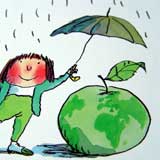
The Young Green Consumer Guide
- with cartoons by Tony Ross - was another international bestseller.
Links
The wave diagram
Wave
1
Downwave 1
Wave 2
Downwave 2
Wave 3
Downwave 3
Timelines
Wave 2 We invent the
Green consumer

The Young Green Consumer Guide
- with cartoons by Tony Ross - was another international bestseller.
Links
The wave diagram
Wave
1
Downwave 1
Wave 2
Downwave 2
Wave 3
Downwave 3
Early in 1988, SustainAbility published Green Pages, a survey of the 'green growth' sectors that potentially could drive sustainable development. But the year's real excitement came when our book The Green Consumer Guide was published by Gollancz that autumn.
Rather than handle our green consumer work through John Elkington Associates, we set up SustainAbility - and made it a limited company, to limit liability related to financial risks we incurred by taking over two projects where a financial black hole at the heart of Earthlife had swallowed the funding we had already raised.
SustainAbility staged a 'Green Consumer Week' to coincide with the launch of the Green Consumer Guide, working with a wide range of NGOs, with funding from WWF and PR help from Lynne Franks. The book and Week did spectacularly well, with The Guide eventually hitting the No. 1 slot in the non-fiction bestseller lists. It, and its various variants, went on to sell over a million copies in around 20 countries worldwide.
The events of the following year were recorded in what was literally my first-ever diary, published as A Year in the Greenhouse. One of the biggest stories for us that year was a protracted battle with McDonald's, which ended in a draw, after the most amazing helter-skelter ride, described in the book.
McDonald's aside, one of the biggest changes for us after The Green Consumer Guide appeared was that companies were almost literally queuing at our door. In the past, we had been able to work for competitors at the same time, because the issues were not considered to be competitive. Now, however, they were seen to be competitive - and we suddenly had to choose between rival prospective clients. Our work also became more international, with a fair number of clients during this period being US multinationals, including Dow Chemical, IBM and Procter & Gamble. Another key client relationship that started at this time was with Denmark's Novo Nordisk working with people like Lise Kingo.
In 1989, Julia and I were elected to the United Nations Global 500 Roll of Honour for "outstanding environmental achievements."
We continued to crank out a series of green consumer books, some of which also went on to become bestsellers. Their number included The Green Consumer's Supermarket Shopping Guide (1989), The Young Green Consumer Guide (1990) and Holidays That Don't Cost the Earth (1992). A number of these coincided with events we organised, among them the 'Britain's Greenest School Competition' (1990) and 'The Holiday Extravaganza' (1992).
One area that had struck business as potentially much more important once the green consumer revolution got under way was environmental auditing. Manufacturers, growers and retailers found themselves hit by one campaign after another, but had little idea of what the real issues were either in their own plants or in their supply chains. We gave a big push to this field with a report for WWF, The Environmental Audit, which was published in 1990.
During this period, SustainAbility began to find its feet, moving
out of our Barnes home and in alongside Brand New Product Development, run
by Dorothy Mackenzie, in London's Notting
Hill area. After several years there, we moved to The People's Hall, Latimer
Road, in what was once declared the 'Republic of Frestonia'. Indeed, our two
studios in the People's Hall had once served as Frestonia's 'National Theatre'.